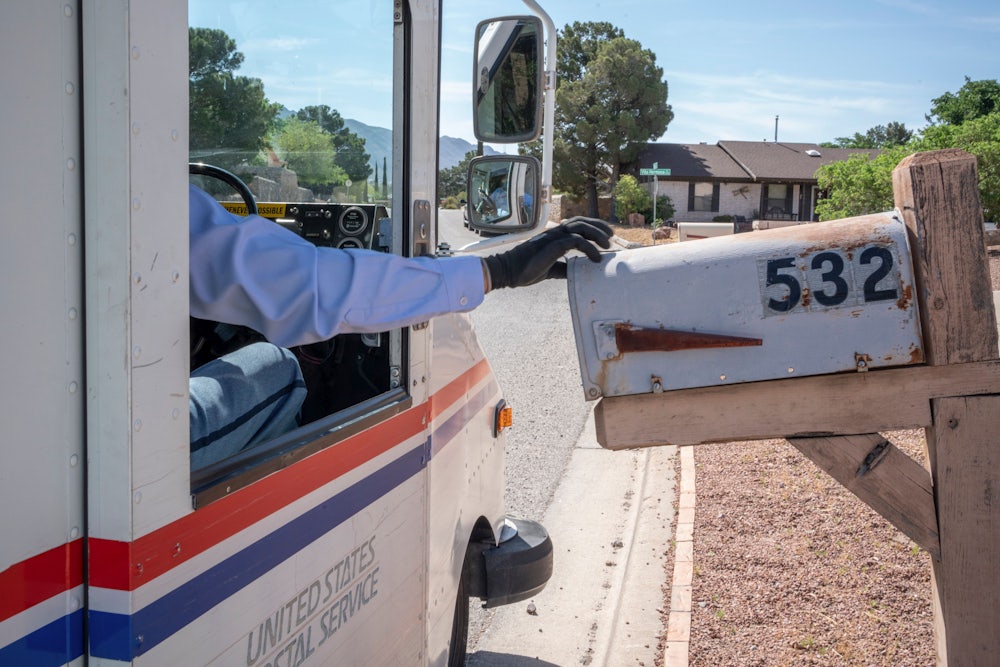Four months ago, the United States Postal Service warned Congress that it could run out of money by September, requesting a $75 billion bailout amid an unprecedented decrease in revenue due to Covid-19. But it wasn’t until last week that the media fully woke up to the crisis at the USPS. All it took was the president admitting, on live television, that he planned on tampering with the upcoming election.
Speaking to Fox Business’s Maria Bartiromo about why he opposes a Democratic stimulus bill, Donald Trump gave the game away. “Now, they need that money in order to make the Post Office work, so it can take all of these millions and millions of ballots,” he said. “If they don’t get those two items, that means you can’t have universal mail-in voting, because they’re not equipped.” Slowing the mail service could lead to thousands of votes being thrown out in key swing states and lengthen the time it would take to count ballots, allowing Trump to claim victory or challenge the legitimacy of the election itself.
It was revealing that it took the president admitting to a vast ballot-tampering scheme to get cable news outlets and major newspapers to put a spotlight on the crisis at the USPS. The roots of that crisis go back years, but the press has failed to adequately convey what’s happening to one of this country’s genuinely great institutions. The USPS’s reputation as the federal government’s version of the DMV—a derelict organ of big government that is chronically in need of a bailout—has been built on the press’s absorption of Republican talking points.
The president and Louis DeJoy, the almost comically corrupt Trump donor who was appointed postmaster general in June despite having no relevant experience, have made this crisis significantly worse. Trump has always seen the Postal Service as leverage in his battle against The Washington Post owner Jeff Bezos, whose main gig, Amazon, benefits from a sweetheart deal with the USPS. DeJoy has rapidly ushered in a host of reforms aimed at cutting costs (such as reducing overtime hours) and boosting “efficiency,” which should be familiar to anyone who has covered the vampiric influence of private equity in recent years. The result has been a dramatic deterioration of service. The USPS recently delivered more than 97 percent of its packages on time; that number is now close to 80 percent and continues to fall.
DeJoy has also drastically cut back on letter-sorting machines. Initially, USPS leadership insisted that these reductions were also being made in the name of efficiency, but as Vice’s Aaron Gordon reported on Friday, these machines are not being reallocated. Instead, DeJoy is eviscerating postal workers’ ability to deliver the mail on time. These machines would have been used to sort mail-in ballots in November, and there is no sensible reason for getting rid of them. (One postal worker, who was told by higher-ups to expect to lose machines in his district, explained to me that these machines can’t be used for anything else and have no resale value.) The most straightforward explanation is that DeJoy is undermining the USPS’s efficiency for the same reason that Trump is resisting funding the organization: because it helps the president’s prospects for reelection.
But the decimation of the USPS is not just a Trump story. The Postal Service was on the brink of collapse long before DeJoy was appointed and long before Donald Trump was elected. The corrupt tinkering of the past two months has compounded years of neglect. The privatization of the Postal Service has been a long-standing conservative project—one that has quietly been successful. Passed in 2006, The Postal Accountability and Enhancement Act required USPS to fully fund its pension program 75 years in the future, blowing a $72 billion hole in the institution’s budget and instantly making it unprofitable. Without the PAEA, the USPS would have posted a profit in the years leading up to the current economic crisis. No other federal institution is forced to comply with such an absurd mandate, but the USPS does because it has been painted as a bloated bureaucracy that exists to hand money out to lazy postal workers.
The press tends to cover government agencies through a political lens that has been shaped by Republicans. When journalists see inefficiency–when they walk into the drab, life-sucking interior of the average big-city post office–they don’t see neglect or sabotage; they see “broken government.” Of course, USPS is struggling to keep up in the internet age, particularly with competitors like UPS and FedEx. (Never mind that the Postal Service deals with 100 times more volume than either company.) But Republicans dislike the post office for ideological reasons more than practical ones. That the USPS is America’s most beloved public institution, that it is actually a symbol of good government, puts a target on its back.
The press excels at covering the efficiency of private institutions but struggles to capture the values of public ones. “We’re going to kill one of the last good public institutions so that private enterprise can deliver a few more packages for less money,” Casey Taylor wrote in The New Republic last week. Furthermore, the specific reasons the USPS is struggling—an arcane financing mechanism that was demanded by Republican lawmakers and agreed to by cowardly Democrats—is never front and center. There’s only the vague impression that the Postal Service is broken, just like everything else, as if that is just the way things are.
But it was not preordained that the Postal Service would be in shambles. Now, at long last, the media is paying attention to what’s happening to the USPS. And it is covering this crisis the way it has covered so many others during the Trump era: as one inexorably tied to our feckless president and his band of loyal goons. The threat to November’s elections is very real. But the larger crisis at the Post Service is bigger than Donald Trump.
